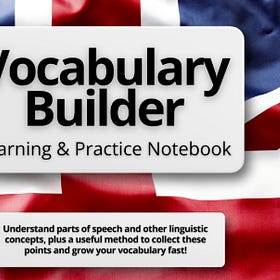4 Surprising Secrets to Supercharge Your English Learning with AI
Unlock Your English Potential
Do you ever feel like your AI practice partner is... a little boring?
You ask it to “practice English,” and it gives you a simple “Hello! How are you?”
If so, you’re not alone.
But what if I told you that you’re using the equivalent of a supercomputer to do basic maths?
Most learners are using just a fraction of their AI tutor’s real power. They are missing the most effective ways to make their learning faster and more fun.
In this article, I’m going to show you four surprising secrets to change how you use AI. You will learn how to turn it into a powerful, personal English tutor that is available anytime you need it.
Let’s unlock the full potential of your AI learning partner!
1. Your AI Is a Personal Actor for Real-Life Practice
One of the biggest challenges for language learners is the fear of making mistakes. Speaking in front of other people can feel scary, and this fear can stop you from practising. But to improve, you need to speak.
This is where AI can be a game-changer.
Think of your AI as a personal actor. You can ask it to “role-play” different situations with you. It creates a safe space where it is okay to make mistakes because no one is judging you. You can practice as many times as you want until you feel confident.
Here are a few real-life scenarios you can practice with your AI partner:
• A job interview
• Ordering food in a cafe or restaurant
• Asking for directions while travelling
• Making plans with a friend
Practising these situations helps you build confidence for when you have to do them in the real world. You can prepare your words and feel ready for any conversation.
Speaking another language in public makes many people feel nervous. In fact, the sensation has its own label – xenoglossophobia... to improve your language proficiency, you simply have to speak it.
But to make your AI actor truly effective, you need to give it a great script. That brings us to our next secret: you must be the director.
2. You Need to Be the Director: The Secret of a “Good Prompt”
To get the best help from your AI, you need to give it good instructions. These instructions are called “prompts.” The quality of the AI’s answer depends completely on the quality of your prompt.
A weak, simple prompt will give you a weak, unhelpful response.
A strong, detailed prompt will give you a very useful one.
Think of it this way: if you give unclear instructions, you will get an unclear result. You need to be the director and tell the AI exactly what you want it to do.
Look at the difference between a weak prompt and a strong prompt:
Weak Prompt
“Let’s practice English.”
Strong Prompt
“Let’s role-play a conversation where I order dinner at a restaurant. Correct my pronunciation and sentence structure as we go.”
Weak Prompt
“Help me with my writing.”
Strong Prompt
“Correct this message and explain my mistakes in simple English.” (from Michigan Language Assessment)
Strong prompts work better because they give the AI a clear job, a specific role to play, and a goal to achieve. This makes your practice sessions much more effective and helps you learn exactly what you need.
Giving clear directions is the key to getting great practice. But even with the perfect prompt, it’s important to remember that your AI is just a tool, and like any tool, it has its limits.
3. Don’t Trust Your AI Completely (It Makes Mistakes, Too!)
Here’s a secret that might surprise you, and it’s one I tell all my students: you shouldn’t always trust your AI. It is an amazing tool, but it is not perfect.
You need to remember that AI can make mistakes.
Here are two key limitations to keep in mind:
1. It can be wrong: Sometimes, an AI can “hallucinate.” This means it generates false or misleading information that sounds correct but is not accurate. It is always a good idea to check important feedback, like complex grammar rules, with a teacher or a trusted textbook.
2. It can sound robotic: AI tools don’t understand language like humans do. They simply predict the next most likely word based on patterns. Because of this, their writing can sometimes sound unnatural, too formal, or strange.
The best strategy is to use AI as one of many tools.
Combine your AI practice with lessons from a teacher, other language apps, and, most importantly, real conversations with people. This will give you a much more complete and natural learning experience.
Use AI in a way that supports critical thinking, not replaces it. (from University of Louisiana at Lafayette)
Using your AI with critical thinking is key, and one of the smartest ways to use it is by telling it to create exactly what you need to learn.
4. Build Your Own Personal Textbook
This is one of my favourite strategies, and it’s incredibly powerful. I call it “building your own personal textbook.”
Instead of using a generic textbook that might not focus on your needs, you can ask the AI to become your personal textbook creator.
You can ask the AI to generate specific exercises, explanations, and lists that target the exact areas you want to improve. This makes your study time incredibly efficient because you are only working on what is important for you.
Here are some examples of what you can ask your AI to create:
Ask for a quiz on common English idioms or phrasal verbs.
Ask for a simple explanation of a complex grammar rule, like the difference between ‘will’ and ‘going to’.
Ask for a formatted table of the 100 most common words in English with translations.
Ask for a funny story that helps you learn specific vocabulary, like colour and animal words.
By creating your own materials, you take control of your learning. You can focus on your weaknesses, practice what is interesting to you, and build a “textbook” that is perfectly designed for your success.
Watch this to help you…
Conclusion: Your AI Is a Tool, But You Are the Learner
Remember, AI is your tireless practice partner, your personal textbook creator, and your rehearsal studio. But you are the director. You are the one who turns its power into your progress. By using these secrets, you can make sure every minute you spend practising is practical and fun.
Use these strategies to practice smarter, not just harder, and take control of your English journey. Your AI is an incredible tool to support your learning, but you are the one who will achieve fluency.
Now that you know these secrets, what is the first new prompt you will try this week to practice your English?
Prompts for English Language Learners
Create a 30-day learning plan (Intermediate → Fluent)
Copy the text below, paste it into your chosen AI (ChatGPT, Gemini, etc), and press enter.
Context: I want to create a 30‑day learning plan to improve my English. My goal is to move from intermediate level to fluent. I can study for 30 minutes every day. I need a plan that starts with review of basics and then builds step by step to advanced skills.
Role: Act as an experienced English teacher who has helped many learners become fluent. Please design a plan that is clear, motivating, and not too difficult.
Action: Create:
A 30‑day plan with weekly themes (for example: vocabulary, grammar, speaking, listening, writing)
Daily study tasks (each 30 minutes, simple and practical)
Resource suggestions (books, websites, videos, apps)
Small tests or checkpoints to check my progress
Practice activities to use English in real life
Format: Please organize the answer like this:
Weekly theme overview
Daily tasks (clear and simple)
Resources/tools for the week
Success goals for the week
Practice assignments
Tone/Preferences:
Use clear and simple English
Mix ideas (theory) with practice (activities)
Give options for different learning styles (reading, listening, speaking, writing)
Focus on practical steps, not too much theory
Share tips to stay motivatedGrow your vocabulary
Copy the text, paste it into your chosen AI (ChatGPT, Gemini etc) and press enter. Then give it the word you want to expand on. Try ‘manage’ as an example! Then just keep entering a new word each time (there is no need to enter the main prompt again!)
Provide the following for the word I give you:
Verb
Noun
Adjective
Adverb
Synonyms
Antonyms
Phrasal Verbs
Collocations
Idioms
Prefixes
Suffixes
Please present the information clearly, following the categories listed.
And then log the vocabulary in a study book!
I have created one for you!
The Plan This Week
We will be focusing on a variety of aspects of AI:
Tomorrow we will talk about AI tools, the assistant in your pocket!
BizPod on Wednesday will be a conversation about whether AI will replace us!
Thursday we introduce the new AI grammar checker app for the ELL!
Friday we end the week with useful vocabulary and expressions when you are talking TO and WITH AI.
Remember, only today and Wednesday are FREE posts. If you want to access the rest then you need to become a FULL/PAID subscriber. Now’s the time!




